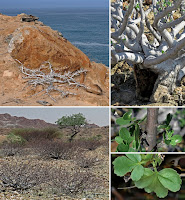 |
| Commiphora omundomba Swanepoel & Weeks, in Swanepoel, Weeks & van Wyk, 2022. Photographs by W. Swanepoel. |
Abstract
Commiphora omundomba, described here as a new species, is known only from the Kaokoveld Centre of Endemism, a biogeographical region in southwestern Angola and Northwestern Namibia. It has hitherto been confused with C. dinteri from west-central Namibia, but both morphological and molecular evidence support a distinction between the two species. Phylogenetic analysis of DNA sequence data indicates that C. omundomba shares most-recent common ancestry with C. buruxa, a species limited to the Gariep Centre of Endemism in southwestern Namibia. Diagnostic morphological characters for C. omundomba include the white, viscous exudate, smooth bark and glabrous, trifoliolate leaves. Photographs of the plant and a distribution map are provided. The new species is mainly confined to near the Atlantic coast of the northern Namib Desert, and is widespread and locally common between Santa Maria in Angola and Puros in Namibia.
Keywords: Commiphora buruxa, Commiphora dinteri, Iona National Park, Kaokoveld Centre of Endemism, Namib Desert, phylogeny, Sapindales, systematics, taxonomy
Commiphora omundomba Swanepoel & Weeks, sp. nov.
Diagnosis:— Differs from C. dinteri in the terminal leaflets being oblanceolate or narrowly obovate (vs. obovate); lateral leaflets oblanceolate, narrowly obovate, obovate, elliptic, oblong, or suborbicular (vs. broadly elliptic or suborbicular); ratio length of terminal leaflets to width being 1.9–3.2:1 (vs.1–2:1); ratio length of terminal leaflets to lateral leaflets being 1.1–1.4:1 (vs. 1.5–2.9:1); leaflet margins often entire (vs. always toothed); calyx eglandular (vs. glandular); number of calyx lobes and petals 3 or rarely 4 (vs. 4); number of disc lobes 3 or rarely 4 (vs. 4); in male flowers distal part of disc lobes adnate to hypanthium, obscurely bifid at apex (vs. distal part not adnate to hypanthium, distinctly bifid at apex); pseudo-aril with commissural arms shorter, extending 25–65% the length of putamen (vs. longer, 75–95%).
Etymology and common names:—The specific epithet is the local Ovahimba vernacular name (a dialect of Otjiherero) for the new species. As vernacular names in English and Afrikaans we propose Iona corkwood and ionakanniedood.
Wessel Swanepoel, Andrea Weeks and Abraham E. van Wyk. 2022. Commiphora omundomba (Burseraceae), A New Species from Angola and Namibia. Phytotaxa. 543(4); 207-218. DOI: 10.11646/phytotaxa.543.4.1






